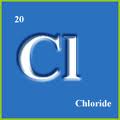Introduction

What is Chloride?
Chloride is an ion of the element chlorine that is commonly part of salts. Chloride found in soil comes from rain water, sea spray, dust, and air pollution (White, 2001). Plants easily absorb chloride (Hudler, n.d.). In fact, chloride is a nutrient essential for plant growth, playing a crucial role in photosynthesis and assisting plants with osmosis. Too little chloride in soil causes chloride deficiency in plants, leading to negative symptoms such as a higher vulnerability to diseases. However, a surplus of chloride in soil leads to chloride toxicity (Lamond & Leikan, 2002).
Chloride's role in soil ecology:
Chloride is a micronutrient, or a chemical required in small amounts for the growth of plants. Chloride is found in almost all soils. Chloride, along with other chemicals like Sulfur or Potassium, in soil helps plants grow. Soil is filled with macro- and micro- nutrients that plants absorb to perform different functions. Chloride is one of these 17 nutrients deemed essential to plant growth. (Oxford, n.d.)
How does Chloride interact with plants?
Plants are capable of absorbing chloride, and they
actually need chloride to survive (Hundler, n.d.). Chloride is required for
plant photosynthesis and assisting with osmosis (Lamond & Leikan, 2002).
Furthermore, chloride is essential for opening and
closing a plant’s stomata (Schnabl & Rashke, 1980). The stomata is surrounded by
cells known as the guard cells. These guard cells open and close the stomata to
regulate the process of tranisiration, or the loss of water through the plant’s
leaves (Jarvis & McNaughton, 1986). Transpiration is necessary in order to move
minerals throughout the plant, cool the plant, and create turgor pressure in
order to keep the plant upright (Whiting, Roll & Vickerman, 2010).
Problems with Chloride Levels: Deficiency vs. Toxicity
Just like most things, it's bad to have a deficiency and it's as bad to have a high toxicity. When there is a chloride deficiency in the soil, it negativley impacts the plants. Identifying chloride deficiency in plants can be dificult because the signs are very similar to many common plant diseases. There are usaully small white spots on the edge of the leaves and the tip of the leaves usually curl up and decay away (Wahlig and Media 2013). In addition, a chloride toxicity can be very harmful to the plants and soil. Symptoms include the edges of the leaves decay away which is known as marginal necrosis (B.A Goodrich 2013).
2013 Chloride Levels, and why we decided to investigate them:
The chloride levels in the year 2012 were pretty consistent with the exception of site four. Site four had a Chloride level of 29.17ppm while the other three sites were between 120-170ppm. (E.S.S.R.E 2012). This year, there was an additional inconsistensy with site four except the chloride levels were extreamly high rather than extreamly low. Site four has a chloride level of 800ppm while the other three sites had chloride levels between 110-170ppm. (E.S.S.R.E 2013).The Chloriders decided to investigate this years chloride levels because the levels were so drastically different and there seemed to be no logical answer as to why this was. This of course made us curious to find a logical answer as to why the chloride levels are so high. We predicted that the reason as to why the chloride levels were so high was because of the type of plants in site four. The levels of chloride were dependent on the variation of planst in the site. We designed our experiment the way we did because it tested exactly how the chloride levels varied when in a negative control (no plants) and when there were plants.
http://www.spectrumanalytic.com/support/library/ff/Cl_Basics.htm